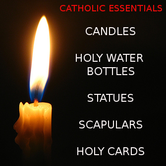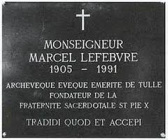
As we have seen mildness helps to prevent us from doing harm to our neighbor not only through anger, but also through fraud or deceit. To this pertains "faith," if we take it as denoting fidelity. But if we take it for the faith whereby we believe in God, then we are directed thereby to that which is above him, consequently, all that is his, to God. In contrast to heresy there is faith.
Natural faithfulness is committing oneself to something or someone, for instance, to one's spouse, to a cause. Being faithful requires personal resolve not to wander away from commitments or promises. It's not always easy to be faithful. "O Lord, thou art my God; I will exalt thee, I will praise thy name; for thou hast done wonderful things; thy counsels of old are faithfulness and truth". "I pray that out of his glorious riches he may strengthen you with power through his Spirit in your inner being, so that Christ may dwell in your hearts through faith".Eph 3. 16-17
St. Paul to the Hebrews describes it this way: "Let us fix our eyes on Jesus, the origin and the crown of all faith, who, to win his prize of blessedness, endured the cross and made light of its shame, Jesus, who now sits on the right of God’s throne." Heb. 12, 2
The root of pistis ("faith") is peithô that is to persuade or be persuaded which supplies the core-meaning of faith as being "divine persuasion", received from God, and never generated by man.
Modesty - Man is well disposed in respect of that which is below him, that is those things below our intellect. This fruit flows through to our external action, by "modesty," whereby we observe the "mode" in all our words and deeds
Catholics are expected to dress modestly; it is recognised that the forms taken by modesty vary from one culture to another. The wearing of a head-covering at Mass was for the first time mandated as a universal rule for the Latin Rite by the Code of Canon Law of 1917, Pope Pius XII stated that women should cover their upper arms and shoulders, that their skirts should cover at least as far as the knee, and the neckline should not reveal anything. Giuseppe Cardinal Siri of Genoa stated that trousers were unacceptable dress for women. Many traditional Catholics have attempted to further expand on this latter standard.
Around 1913, it became fashionable for dresses to be worn with a modest round or V-shaped neckline. In the German Empire, for example, all Roman Catholic bishops joined in issuing a pastoral letter attacking the new fashions.
As Chesterton remarks in What's Wrong with the World Part 3, V
And since we are talking here chiefly in types and symbols, perhaps as good an embodiment as any of the idea may be found in the mere fact of a woman wearing a skirt. It is highly typical of the rabid plagiarism which now passes everywhere for emancipation, that a little while ago it was common for an "advanced"woman to claim the right to wear trousers; a right about as grotesque as the right to wear a false nose. Whether female liberty is much advanced by the act of wearing a skirt on each leg I do not know; perhaps Turkish women might offer some information on the point. But if the western woman walks about (as it were) trailing the curtains of the harem with her, it is quite certain that the woven mansion is meant for a perambulating palace, not for a perambulating prison. It is quite certain that the skirt means female dignity, not female submission; it can be proved by the simplest of all tests. No ruler would deliberately dress up in the recognized fetters of a slave; no judge would appear covered with broad arrows. But when men wish to be safely impressive, as judges, priests or kings, they do wear skirts, the long, trailing robes of female dignity The whole world is under petticoat government; for even men wear petticoats when they wish to govern.




